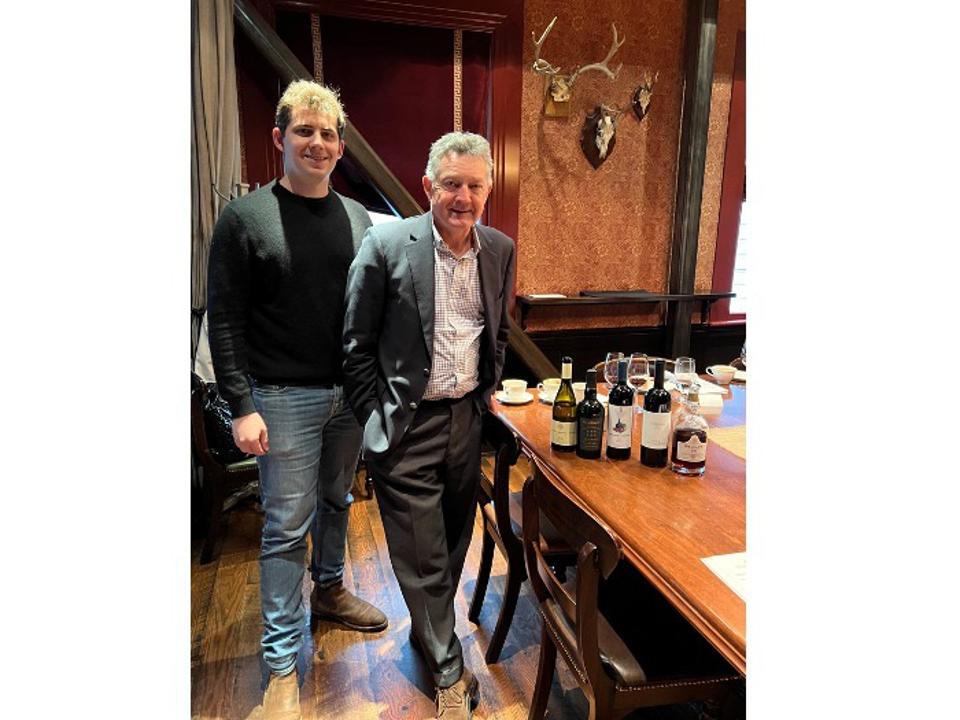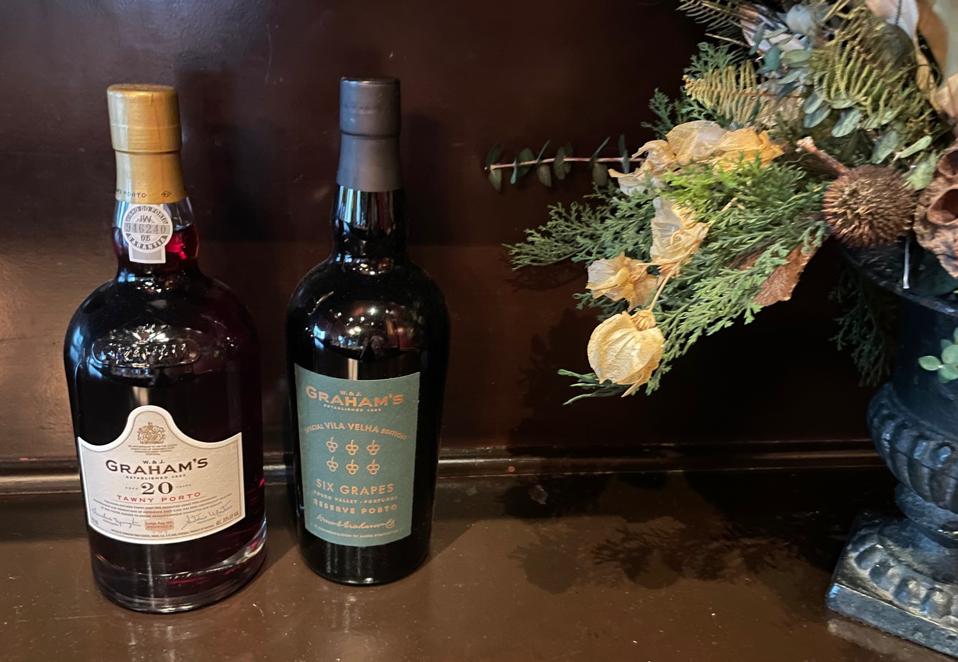Rupert Symington, CEO of the Symington Family of Wines, grew up in the Douro region of Portugal, surrounded by some of the steepest and most stunningly terraced vineyards in the world. Named by UNESCO as a world heritage site due to its history of producing wine for more than 2,000 years and the architectural feat of the terracing, Symington is concerned about the impact of climate change on this special region of the world, and the fact that the famous red port produced here is currently waning in volume sales.
However, the Symington family, that has grown grapes and made port wine here for five generations, is fighting back with cutting edge sustainability programs and innovative port and still wine products. During a lunch with Rupert Symington and his son, Hugh Symington, Marketing Manager at the family’s Premium Port Wine importing company, both men described some of the steps they have taken to address these issues.
“The Sahara desert is creeping north in Portugal,” Rupert Symington stated. “Climate change has made it more challenging to grow certain grape varieties, such as Touriga Franca, that has thinner skins.”
“Furthermore, the younger generation is not adopting port as much as they did in the past,” he continued. “We were told several years ago that port is doomed, but we have proved them wrong.”
Given that the Symington wine empire started in 1882, includes 1,024 hectares (2,530 acres) of vines, and such prestigious brands as Graham’s, Warre’s, Dow’s and Cockburn’s, as well as a portfolio of still wines, it is not surprising that they are fighting back. “We have always taken a long-term viewpoint, and we believe the future of our region is to keep the people who farm the vineyards sustainable.”
Symington Becomes Portugal’s First B Corp
Part of this long term strategy was the decision of the Symington Family to pursue B Corp status. B Corp is a global group of companies that have been certified by a third-party as meeting high standards for environmental and social programs, as well as changing corporate governance structure to be accountable to all stakeholders, and exhibiting transparency on all of these aspects. In 2019, they were the first company in Portugal to achieve B Corp status.
According to Rob Symington, Hugh’s cousin and Director of Marketing and Sustainability, “We became a B Corp as it is the most comprehensive and rigorous company-wide sustainability framework in the world. We want to avoid the trap of greenwashing. We like the fact that it drives continuous improvement across the pillars of Governance, People, Supply Chain, Community and Environment.”
In addition to B Corp, Symington is also a silver member of the International Wineries for Climate Action (IWCA), and owns the largest area of certified organic vineyards in northern Portugal (112 hectares, or 276 acres).
Rob Symington added that, “sustainable viticulture and low-impact wine-making are very much on the radar in Portugal, as is research into climate change adaptation in the vineyard and, increasingly, attempts by some wineries to reduce their carbon emissions.”
Hugh and Rupert Symington of Symington Family Wine Estates in Portugal
Product Innovation at Symington
Even though port wine has seen some volume decline over the years, it has increased in value. According to the Institute of Douro Wine and Port (IVDP), over the past decade port sales grew from €356 million in 2012 to €380 million in 2022, though at the same time volume decreased by 12 million liters.
Part of the reason for the value increase is that many Millennials started adopting port, especially white port as a cocktail mixer. According to Rupert Symington, “the younger generation is sold on port mixers, but I think this is OK, because people will adopt traditional port as they grow older.”
Tawny (golden colored) port has also seen an increase in sales over dark red port. “Right now, one in every four bottles of wine we sell is tawny port,” reported Hugh Symington. “It used to be one in ten, but tawny port has become very popular. In the last year we sold almost a half a million cases of tawny port for around $40 million. Port sales also boomed during Covid.”
But the Symington’s are not betting only on port, because they have increased their product innovation around still wine (non-fortified) production. To do this they are using the indigenous grapes of Portugal that were primarily used for port production, and now making still wines with them as well.
Some of Portugal’s indigenous grapes include red grapes, such as Touriga Nacional, Touriga Franca, Tinta Roriz, Tinta Barroca, Tinta Cão and Tinta Amarela, and white grapes, like Verdelho, Arinto, Gouveio, and Malvasia Fina.
During the lunch at the Wayfare Tavern in San Francisco, we were able to try three of the still wines made from some of these fascinating grapes, as well as a tawny and red port.
Special Symington Family Still Wines Made with Indigenous Portuguese Grapes
Red Portuguese Wine with Fish
If you don’t believe that red wine should be paired with fish, then take a trip to Portugal. As a country that is surrounded by the ocean, they pair all types of fish dishes with wines of all colors – red, white and rose, as well as sparkling, port, and port cocktails. During the lunch we were able to experiment with five Symington wines paired with different dishes, and it was quite eye-opening.
1) Quinta da Fonte Souto 2020 ($26) this still white wine was made from Arinto and Verdelho grapes. Partially fermented in large oak barrels, it had notes of golden apple, hazelnut and citrus, with medium body and hints of minerality. It was paired with dual appetizers of prime beef tartare and burrata toast. Surprisingly the texture of the white wine was able to cut through the richness of the beef.
2) Comboio do Vesuvio Douro DOC 2019 ($22) – this still red wine was made from 4 of the 5 traditional red grapes used in port: Touriga Nacional, Touriga Franca, Tinta Roriz, and Tinta Barroca. It was unoaked, cheerful and fruity, with notes of mixed berries and spice. This was one of two red wines paired with a Skuna Bay Salmon with red cabbage, and it worked surprisingly well.
3) Prats & Symington Chryseia Douro DOC 2019 ($95) – this still red wine was massive and complex, made from 75% Touriga Nacional and Touriga Franca. It tasted of dark currents, earth, herbs, and spice with massive, though velvety tannins. Again this was paired with a choice of the salmon or the famous proprietary grind burger. This wine has scored very high with wine critics, receiving 95 points from Wine Enthusiast.
4) Graham’s Six Grapes Special Vila Velha Edition ($49) – the meal couldn’t end without a taste of at least two different port wines. The first one was the special edition of the famous Six Grapes label, in which the grapes are specially selected from the Quinta de Vila Velha estate. It was dreamy tasting with thick blackberry, boysenberry and dark chocolate wrapped in a warm semi-sweet finish. Paired with a chocolate opera cake, it took on heavenly dimensions.
5) Graham’s 20 Year Old Tawny Port ($69) – the classic port for which Graham’s is so well known world-wide, this wine was probably the top crowd-pleaser of the meal. Brimming with caramel, orange zest, nuts, and it was softly sweet and satisfying. This golden colored port was paired with vanilla crème brulee, and was absolutely delicious. It has also scored well with critics, receiving 95 points from Decanter.
As the meal ended, Rupert reminded everyone that once opened, a red port will last for around 2 weeks, and a tawny port will keep for 2 months if stored in the refrigerator. “I believe that port should be served at the end of every meal,” said Rupert, concluding the lunch with a final toast.
Graham’s Tawny and Red Ports from the Symington Family Collection



